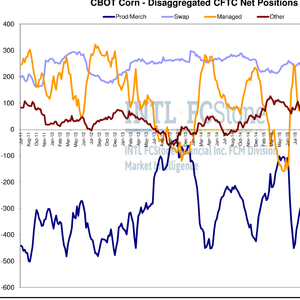Potential for big crop pressures corn prices

July 25, 2016
BY Jason Sagebiel and Geoffrey Utecht , INTL FCStone
The July WASDE report showed a one-half million acres increase in planted corn due to the increase shown on June 30 stocks and acreage report which increased domestic production estimates by 110 million bushels to 14.54 billion bushels. Export demand jumped 100 million bushels as Mexico and Japan are expected to increase their demand for U.S. corn. Ultimately with bigger stocks from the June stocks report and bigger production, projected carryout increased by 73 million bushels from the June report. The market was caught off guard by the month-end stocks and acreage report. Planted acres were expected to decline by 1 million and ending stocks were expected to be 200 million bushels lower than the report indicated. These surprises in the report caused pressure on the corn market which slowed movement in the cash market from producers.
The USDA decreased last years’ Argentina production by 1 million metric tons (mmt) Brazilian production saw a 2 mmt decrease from last month and now is 7.5 mmt lower than last year’s production.
Many areas of the Corn Belt saw extended dry periods during June and weather models predicted above normal temps and below normal precipitation in July and August. However, the dry areas of the belt saw relief from the heat with timely rains that continued into the month of July as weather experts pushed back their high heat forecasts further into August. The report data combined with the timely rains and lack of heat prompted managed money to liquidate their positions from roughly 250k long contracts in June to nearly even by the middle of July. Crop conditions have been steady and held in well this year: nationally 76 percent good to excellent during June into July compared to the five -year average for good to excellent rating in the mid-60 percent during the same the period.
Advertisement
Advertisement
The chart illustrates the change in positions over a period of time particularly noting the recent managed money position.
Comments in this article are market commentary and are not to be construed as market advice
Advertisement
Advertisement
Related Stories
The U.S. exported 31,160.5 metric tons of biodiesel and biodiesel blends of B30 and greater in May, according to data released by the USDA Foreign Agricultural Service on July 3. Biodiesel imports were 2,226.2 metric tons for the month.
CARB on June 27 announced amendments to the state’s LCFS regulations will take effect beginning on July 1. The amended regulations were approved by the agency in November 2024, but implementation was delayed due to regulatory clarity issues.
Legislation introduced in the California Senate on June 23 aims to cap the price of Low Carbon Fuel Standard credits as part of a larger effort to overhaul the state’s fuel regulations and mitigate rising gas prices.
The government of Brazil on June 25 announced it will increase the mandatory blend of ethanol in gasoline from 27% to 30% and the mandatory blend of biodiesel in diesel from 14% to 15%, effective Aug. 1.
The U.S. EIA reduced its 2025 and 2026 production forecasts for a category of biofuels that includes SAF in its latest Short-Term Energy Outlook, released June 10. The forecast for 2025 renewable diesel production was also revised down.
Upcoming Events









